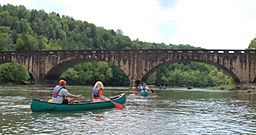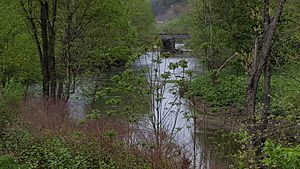Cumberland River facts for kids
Quick facts for kids Cumberland River |
|
|
Canoers on the Cumberland River upstream from Cumberland Falls
|
|
| Country | United States |
|---|---|
| States | Kentucky, Tennessee |
| Tributaries | |
| - left | Martins Fork, Clear Fork, Big South Fork, Obey River, Caney Fork, Stones River, Harpeth River |
| - right | Clover Fork, Poor Fork, Laurel River, Rockcastle River, Red River, Little River |
| Cities | Williamsburg, KY, Burkesville, KY, Carthage, TN, Nashville, TN, Clarksville, TN, Dover, TN |
| Source | Confluence of Clover Fork and Martins Fork |
| - location | Baxter, Kentucky |
| - elevation | 1,158 ft (353 m) |
| Mouth | Ohio River |
| - location | Livingston County, Kentucky |
| - elevation | 302 ft (92 m) |
| Length | 688 mi (1,107 km) |
| Basin | 17,728 sq mi (45,915 km²) |
| Discharge | for below Barkley Dam, about 31 mi (50 km) from the mouth |
| - average | 37,250 cu ft/s (1,055 m³/s) |
| - max | 209,000 cu ft/s (5,918 m³/s) |
| - min | 6,085 cu ft/s (172 m³/s) |
The Cumberland River is a very important waterway in the Southern United States. It flows for about 688 miles (1,107 km) (that's longer than the state of Florida!). This river helps drain water from nearly 18,000 square miles (47,000 km2) of land. This area includes parts of southern Kentucky and north-central Tennessee.
The river starts in the Appalachian Mountains. It generally flows west until it joins the Ohio River. This meeting point is near Paducah, Kentucky. Some of its main smaller rivers that flow into it are the Obey, Caney Fork, Stones, and Red rivers.
Even though much of the land around the Cumberland River is countryside, some big cities are also located along its banks. These include Nashville and Clarksville in Tennessee. People have built many large dams on the river and its smaller branches. These dams help control floods and manage the water.
Contents
Where Does the Cumberland River Flow?
The Cumberland River begins with three separate streams. These streams start in Kentucky and meet in Baxter, KY. This area is in Harlan County. One of these streams, Martin's Fork, starts high up on Brush Mountain. It then winds its way through the mountains to Baxter.
From Baxter, the river becomes wider and is called the Cumberland River. It flows west through the mountains of Kentucky. Then, it turns north towards a famous spot called Cumberland Falls.
Cumberland Falls: The Niagara of the South
Cumberland Falls is a huge waterfall, about 68 feet (21 m) tall. It is one of the biggest waterfalls in the southeastern United States. What makes it extra special is that it's one of the few places in the Western Hemisphere where you can see a "moonbow." A moonbow is like a rainbow, but it's created by moonlight instead of sunlight!
After Cumberland Falls, the river turns sharply west again. It gets bigger as more creeks and streams join it. The Laurel and Rockcastle rivers flow into it from the northeast. Then, the Big South Fork of the Cumberland River joins from the south.
Lake Cumberland: A Giant Man-Made Lake
The river then flows into a large lake called Lake Cumberland. This lake was made by people when they built Wolf Creek Dam. Lake Cumberland is more than 100 miles (160 km) long. It is one of the largest artificial lakes in the eastern United States.
History of the Cumberland River
The explorer Thomas Walker from Virginia named the river in 1758. It's not fully known if he named it after the Duke of Cumberland or the English county of Cumberland.
Before that, the Shawnee Native Americans called the river Wasioto. French traders also knew it as the Riviere des Chaouanons, which means "River of the Shawnee." For many years after Walker's trip, people still called it the Shawnee River.
The Cumberland River was very important for early hunters and settlers. It provided a way to travel and trade. Villages, towns, and cities grew up along its banks. In the middle of the 1800s, people relied on rivers for most of their transportation and trade. Boats would travel from the Cumberland River to the Ohio and Mississippi rivers.
See also
 In Spanish: Río Cumberland para niños
In Spanish: Río Cumberland para niños




